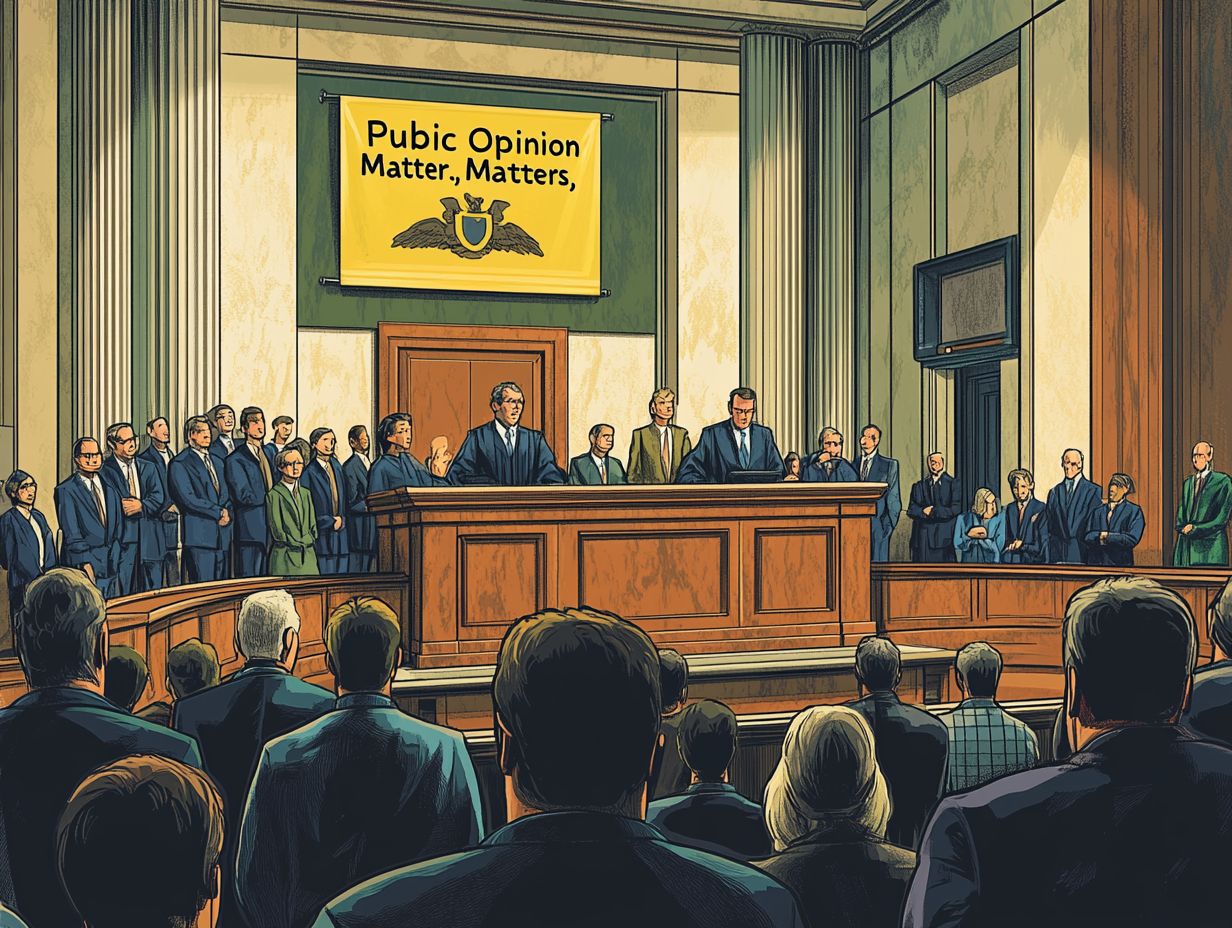The Role of Public Perception in IP Litigation
In the intricate realm of legal cases involving ideas and inventions, the impact of public perception is a pivotal factor that often flies under the radar.
While legal arguments and evidence hold undeniable importance, the sway of public opinion can profoundly influence the outcome of a case. This discussion also looks at how media coverage, corporate reputation, and strategic messaging mold public perception and, ultimately, litigation results.
It examines real-world case studies to highlight the tangible effects of public sentiment in IP disputes. Understanding this dynamic is critical for anyone involved in the fast-paced world of IP law.
Contents
- Key Takeaways:
- Why Public Perception Matters
- Factors Influencing Public Perception
- Strategies for Managing Public Perception
- The Role of Public Perception in IP Litigation Outcomes
- Case Studies: Examples of Public Perception in IP Litigation
- Frequently Asked Questions
- What is the role of public perception in IP litigation?
- How can public perception affect the outcome of an IP litigation case?
- What are some factors that can influence public perception in IP litigation?
- Can public perception be manipulated in IP litigation?
- How important is public perception in settling IP litigation cases?
- Is Public Perception Relevant in IP Litigation Cases?
Key Takeaways:

Public perception can greatly impact the outcomes of IP litigation cases.
Factors such as media coverage and corporate reputation can influence public opinion.
Proactive measures and crisis management strategies are important in managing public perception during IP litigation.
Why Public Perception Matters
Public perception is paramount in Intellectual Property (IP) litigation, as it shapes stakeholders’ comprehension of the IP system and ultimately impacts outcomes in patent disputes, copyright awareness, and trademark litigation.
Recent studies, including those conducted by the Center for Intellectual Property Understanding, reveal that perceptions of IP rights profoundly influence legal strategies and public behavior, especially among EU citizens.
IP professionals must navigate the complex world of IP education and legal counseling. It’s essential to recognize how media coverage molds public opinion. This can not only sway judicial decisions but also transform the very fabric of IP litigation.
Understanding the Impact of Public Opinion
Understanding the impact of public opinion on Intellectual Property (IP) rights is essential for you as an IP professional or legal expert. It significantly shapes the overall perception of the IP system.
Public sentiment is often swayed by a complex interplay of psychological factors, including social conditioning, cognitive biases, and emotional reactions to various IP-related issues.
For example, the growing awareness of copyright infringement and patent trolling, which refers to the practice of aggressively enforcing patent rights against alleged infringers, often without intending to produce or market the patent itself, has resulted in polarized opinions.
To navigate the ever-changing landscape of IP rights effectively, you must grasp these dynamics. Recent studies show a strong correlation between public sentiment and legislative support for IP reforms, indicating that policymakers are increasingly attuned to public voices.
By understanding how these perceptions evolve, you can enable your organization to strategize and advocate for balanced IP policies that reflect not only legal frameworks but also societal values.
Factors Influencing Public Perception
Several factors influence your perception of Intellectual Property (IP) rights, including media coverage, corporate reputation, and advertising regulations.
Together, these elements shape your views on global patent prosecution and the purchase of counterfeits.
Media Coverage and Messaging
Media coverage plays a crucial role in shaping the narrative surrounding Intellectual Property (IP) rights, influencing your understanding and affecting the overall perception of IP education.
Through various channels be it news articles, social media posts, or opinion pieces the narratives surrounding IP issues, particularly patent disputes and trademark litigation, begin to take shape.
The way these stories are framed can significantly sway public opinion, impacting how you perceive the validity of patents or the fairness of trademark claims.
Responsible messaging is vital; sensationalized or biased reporting can lead to misunderstandings, resulting in uninformed judgments from both the public and stakeholders.
By ensuring that coverage accurately reflects the complexities of IP law, the media can cultivate a more nuanced conversation, ultimately benefiting innovation and creativity across industries.
Stay tuned for more insights on how public perception influences IP law and what you can do to make a difference.
Corporate Reputation and Brand Image

Your company s corporate reputation and brand image are vital. They shape how the public views legal protections for creations and inventions, especially in trademark disputes.
When you prioritize transparency and ethical practices, you cultivate trust among consumers. This enhances positive views on your legal protections. A recent study from the Reputation Institute revealed that companies seen as socially responsible experienced a 33% increase in favorable consumer responses during legal disputes involving their trademarks.
Engaging actively with your community and showing your dedication to innovation will boost public perception. For example, a tech giant, known for its impressive IP portfolio, has swayed public sentiment in its favor through educational initiatives that highlight the importance of IP, even amid high-profile litigation.
Strategies for Managing Public Perception
Effective strategies for managing public perception are crucial as you navigate the complex landscape of legal protections for creations and inventions. This is especially important during crises or when facing negative publicity.
Proactive Measures for Maintaining Positive Perception
Maintaining a positive perception of legal protections requires prioritizing effective IP education and actively engaging stakeholders.
Organize educational campaigns that highlight the significance of IP protections. Help the public grasp how these legal safeguards foster innovation and creativity.
Community outreach programs are essential in dispelling myths about IP. They create opportunities for open dialogue and workshops that address common misconceptions.
By collaborating with local schools and universities, you can nurture a generation that values and respects intellectual property, reinforcing its importance in society.
Strategic alliances with influencers and industry leaders can amplify your initiatives. This enhances credibility and expands your reach, contributing to a well-informed public that supports strong IP protection.
Addressing Negative Perception and Crisis Management
Swiftly tackling negative perceptions is essential during crises related to your IP protections. Your reputation is on the line!
In today s fast-paced digital landscape, where information spreads rapidly and public sentiment can change in an instant, your organization s reputation management relies on a coordinated approach.
Effective crisis management strategies should prioritize quick and accurate media responses. Ensure that misleading narratives are countered without delay.
Consistent communication with all stakeholders whether employees, investors, or the public is essential for rebuilding trust. Clarifying your positions, providing regular updates, and showing a commitment to resolving the crisis will significantly enhance your organization s reputation and mitigate the fallout from adverse events.
The Role of Public Perception in IP Litigation Outcomes
Public perception plays a crucial role in shaping the outcomes of IP litigation. Understanding the role of the Internet in IP litigation and attitudes of various stakeholders can significantly impact the trajectory and results of legal proceedings.
This influence is especially pronounced in cases involving high-profile brands or contentious issues, where public emotions can sway juries and judges alike.
Studies indicate that when the public views a major corporation as an underdog against a smaller competitor, the resulting sympathy and support can significantly influence the jury s decision-making process.
Recent research underscores how discussions on social media can ignite public sentiment, adding another layer of complexity to ongoing litigation.
Examining the latest litigation trends reveals that whether public sentiment is favorable or unfavorable can be pivotal in shaping settlement negotiations and, ultimately, the outcomes of IP disputes.
How Public Opinion Can Affect Legal Proceedings

Public opinion can wield significant influence over legal proceedings related to Intellectual Property (IP) rights. It shapes the behavior of stakeholders and guides legal strategies.
Public sentiment is a powerful force in litigation. It serves as an important factor in legal cases.
Stakeholders whether corporations, legal teams, or individual creators keenly observe the prevailing public mood. This directly impacts their responses and decision-making.
For instance, a surge in consumer support for a particular brand may encourage stakeholders to adopt a more aggressive legal approach. Conversely, a wave of negative public sentiment could lead them to explore alternative resolutions outside the courtroom.
In this intricate maze of IP disputes, grasping the nuances of public opinion is essential for stakeholders aiming to navigate effectively and strategically.
Case Studies: Examples of Public Perception in IP Litigation
Examining case studies offers valuable insights into how public perception can influence outcomes in Intellectual Property (IP) litigation, especially in trademark disputes.
Examining Past Cases and Their Outcomes
Looking back at past cases reveals fascinating links between public opinion and legal outcomes.
In several high-profile instances, public sentiment has swayed juries and influenced judges’ decisions. This demonstrates how external opinions can significantly affect the enforcement of intellectual property rights.
Take, for example, the legal battle between Apple and Samsung over smartphone design patents. This clash generated substantial media attention, with the public largely rallying behind Apple, viewing it as the underdog against a larger competitor. This bias arguably led to favorable rulings for Apple, reflecting a broader cultural narrative around innovation and brand loyalty.
Similarly, consider the ongoing struggles artists and musicians face against major music labels in copyright cases. Fans often scrutinize these battles and rally behind their favorites, shaping the narrative surrounding IP enforcement.
These scenarios underscore the critical role societal views play in shaping legal precedents and the overall landscape of intellectual property rights.
Frequently Asked Questions
What is the role of public perception in IP litigation?
Public perception can greatly influence IP cases, impacting the role of IP litigation. It affects how juries and judges view the parties involved and their respective intellectual property rights.
How can public perception affect the outcome of an IP litigation case?

Public perception can affect the outcome of an IP litigation case in various ways. It can influence the jury’s decision as discussed in understanding the role of the jury in IP litigation, sway the judge’s ruling, and affect the public’s buying behavior towards the involved products or brands.
What are some factors that can influence public perception in IP litigation?
Factors influencing public perception in IP litigation include media coverage, prior public opinion about the involved parties, and the perceived value of the intellectual property at stake, as well as understanding the role of the court in IP litigation.
Can public perception be manipulated in IP litigation?
Yes, public perception can be manipulated in IP litigation through strategic media use, public relations, and marketing tactics. However, such manipulation can be challenged and discredited in court if there is evidence of deceit or unethical practices.
How important is public perception in settling IP litigation cases?
Public perception can significantly impact settling IP litigation cases. It may pressure the parties involved to reach a favorable settlement. A negative public perception can also hinder business operations or damage reputations, prompting parties to seek settlements in IP litigation to avoid further harm.
Is Public Perception Relevant in IP Litigation Cases?
No, how people view things matters in all IP litigation cases. It influences outcomes, whether the case is large or small.
This perception can sway decisions significantly. Parties and their attorneys must consider this aspect carefully.






